新标准英语第六册教案
新标准小学英语第六册Module精选Unit教案
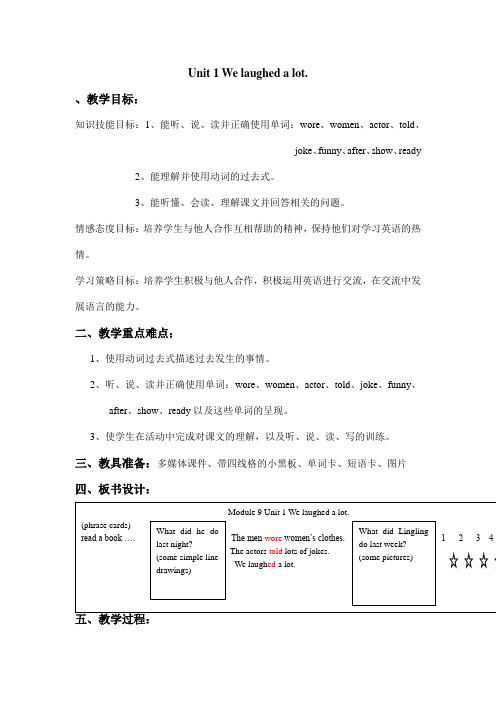
Unit 1 We laughed a lot.
、教学目标:
知识技能目标:1、能听、说、读并正确使用单词:wore、women、actor、told、
joke、funny、after、show、ready
2、能理解并使用动词的过去式。
3、能听懂、会读、理解课文并回答相关的问题。
情感态度目标:培养学生与他人合作互相帮助的精神,保持他们对学习英语的热情。
学习策略目标:培养学生积极与他人合作,积极运用英语进行交流,在交流中发展语言的能力。
二、教学重点难点:
1、使用动词过去式描述过去发生的事情。
2、听、说、读并正确使用单词:wore、women、actor、told、joke、funny、
after、show、ready以及这些单词的呈现。
3、使学生在活动中完成对课文的理解,以及听、说、读、写的训练。
三、教具准备:多媒体课件、带四线格的小黑板、单词卡、短语卡、图片
四、板书设计:。
新标准英语第六册教案
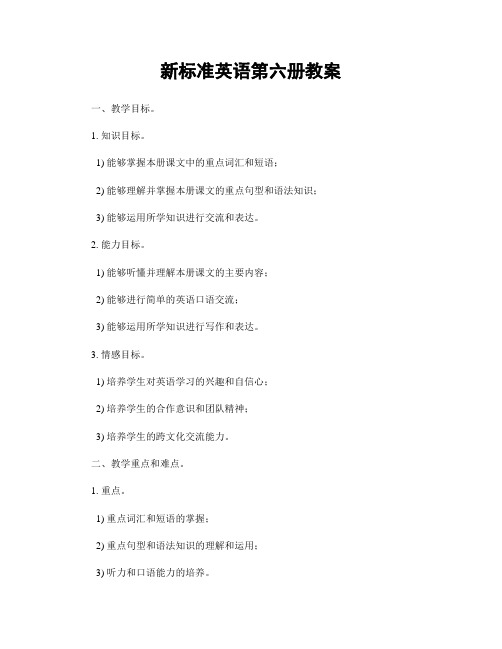
新标准英语第六册教案一、教学目标。
1. 知识目标。
1) 能够掌握本册课文中的重点词汇和短语;2) 能够理解并掌握本册课文的重点句型和语法知识;3) 能够运用所学知识进行交流和表达。
2. 能力目标。
1) 能够听懂并理解本册课文的主要内容;2) 能够进行简单的英语口语交流;3) 能够运用所学知识进行写作和表达。
3. 情感目标。
1) 培养学生对英语学习的兴趣和自信心;2) 培养学生的合作意识和团队精神;3) 培养学生的跨文化交流能力。
二、教学重点和难点。
1. 重点。
1) 重点词汇和短语的掌握;2) 重点句型和语法知识的理解和运用;3) 听力和口语能力的培养。
2. 难点。
1) 学生对课文内容的理解和运用;2) 学生的口语表达能力的提高;3) 学生的写作能力的培养。
三、教学方法。
1. 情境教学法。
通过创设真实的语言情景,让学生在情境中学习和运用英语。
2. 任务型教学法。
通过任务的设置和完成,激发学生的学习兴趣和动力,培养学生的语言运用能力。
3. 合作学习法。
通过小组合作学习,培养学生的合作意识和团队精神,提高学生的语言表达能力。
四、教学过程。
1. 导入。
利用图片或视频引入新课话题,激发学生的学习兴趣,引起学生对新知识的好奇心。
2. 学习新课。
通过听、说、读、写的方式,引导学生学习新课内容,重点讲解课文中的重点词汇、句型和语法知识。
3. 练习与巩固。
设计各种形式的练习题,让学生进行练习和巩固,提高学生的语言运用能力。
4. 课堂表现。
鼓励学生展示他们的学习成果,提高学生的自信心和表达能力。
五、教学反思。
本教案以新标准英语第六册为教学对象,通过情境教学法、任务型教学法和合作学习法等多种教学方法,使学生在轻松愉快的氛围中学习英语,培养学生的语言运用能力和跨文化交流能力。
通过本教案的实施,学生的英语学习兴趣得到了激发,口语表达能力和写作能力得到了提高,整体教学效果良好。
希望在今后的教学实践中,能够进一步完善教学方法,更好地激发学生的学习兴趣,提高教学效果。
新标准英语三年级起点第六册m1u2教案:引导孩子正确学习英语方法
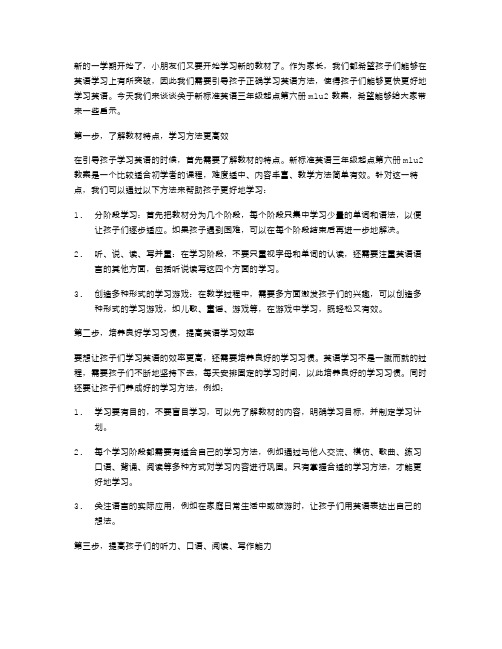
新的一学期开始了,小朋友们又要开始学习新的教材了。
作为家长,我们都希望孩子们能够在英语学习上有所突破,因此我们需要引导孩子正确学习英语方法,使得孩子们能够更快更好地学习英语。
今天我们来谈谈关于新标准英语三年级起点第六册m1u2教案,希望能够给大家带来一些启示。
第一步,了解教材特点,学习方法更高效在引导孩子学习英语的时候,首先需要了解教材的特点。
新标准英语三年级起点第六册m1u2教案是一个比较适合初学者的课程,难度适中、内容丰富、教学方法简单有效。
针对这一特点,我们可以通过以下方法来帮助孩子更好地学习:1.分阶段学习:首先把教材分为几个阶段,每个阶段只集中学习少量的单词和语法,以便让孩子们逐步适应。
如果孩子遇到困难,可以在每个阶段结束后再进一步地解决。
2.听、说、读、写并重:在学习阶段,不要只重视字母和单词的认读,还需要注重英语语言的其他方面,包括听说读写这四个方面的学习。
3.创造多种形式的学习游戏:在教学过程中,需要多方面激发孩子们的兴趣,可以创造多种形式的学习游戏,如儿歌、童谣、游戏等,在游戏中学习,既轻松又有效。
第二步,培养良好学习习惯,提高英语学习效率要想让孩子们学习英语的效率更高,还需要培养良好的学习习惯。
英语学习不是一蹴而就的过程,需要孩子们不断地坚持下去,每天安排固定的学习时间,以此培养良好的学习习惯。
同时还要让孩子们养成好的学习方法,例如:1.学习要有目的,不要盲目学习,可以先了解教材的内容,明确学习目标,并制定学习计划。
2.每个学习阶段都需要有适合自己的学习方法,例如通过与他人交流、模仿、歌曲、练习口语、背诵、阅读等多种方式对学习内容进行巩固。
只有掌握合适的学习方法,才能更好地学习。
3.关注语言的实际应用,例如在家庭日常生活中或旅游时,让孩子们用英语表达出自己的想法。
第三步,提高孩子们的听力、口语、阅读、写作能力在引导孩子们学习英语的时候,我们需要注重提高孩子们的听力、口语、阅读、写作能力。
新标准小学英语三起第六册Module10教案
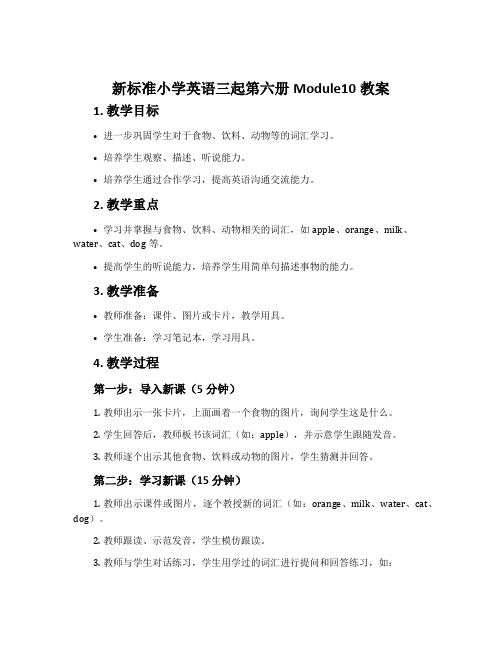
新标准小学英语三起第六册Module10教案1. 教学目标•进一步巩固学生对于食物、饮料、动物等的词汇学习。
•培养学生观察、描述、听说能力。
•培养学生通过合作学习,提高英语沟通交流能力。
2. 教学重点•学习并掌握与食物、饮料、动物相关的词汇,如apple、orange、milk、water、cat、dog等。
•提高学生的听说能力,培养学生用简单句描述事物的能力。
3. 教学准备•教师准备:课件、图片或卡片,教学用具。
•学生准备:学习笔记本,学习用具。
4. 教学过程第一步:导入新课(5分钟)1.教师出示一张卡片,上面画着一个食物的图片,询问学生这是什么。
2.学生回答后,教师板书该词汇(如:apple),并示意学生跟随发音。
3.教师逐个出示其他食物、饮料或动物的图片,学生猜测并回答。
第二步:学习新课(15分钟)1.教师出示课件或图片,逐个教授新的词汇(如:orange、milk、water、cat、dog)。
2.教师跟读、示范发音,学生模仿跟读。
3.教师与学生对话练习,学生用学过的词汇进行提问和回答练习,如:–学生:What’s this?–教师:It’s an orange.第三步:合作学习(20分钟)1.将学生分成小组,每个小组由3-4人组成。
2.每个小组选择一个食物、饮料或动物,用英语进行描述,并写在学习笔记本上。
3.学生进行小组分享,其他小组根据描述猜测所描述的事物。
4.教师在小组分享过程中进行必要的辅导和纠正。
第四步:巩固练习(15分钟)1.教师出示一张包含多个食物、饮料或动物的图片。
2.学生观察后,在学习笔记本上写下自己观察到的事物,并用英语进行描述。
3.学生交换笔记本,互相猜测对方所描述的事物。
第五步:课堂总结(5分钟)1.教师引导学生回顾本节课学习到的词汇,并进行示范发音。
2.学生进行答题练习,教师进行必要的辅导。
5. 课后作业1.完成课本上相关练习。
2.复习本节课学到的词汇,并进行拓展练习。
大连市2012“教学中的互联网搜索”优秀教学案例评选 张洁 新标准英语三起第六册 M2U1 She learnt English
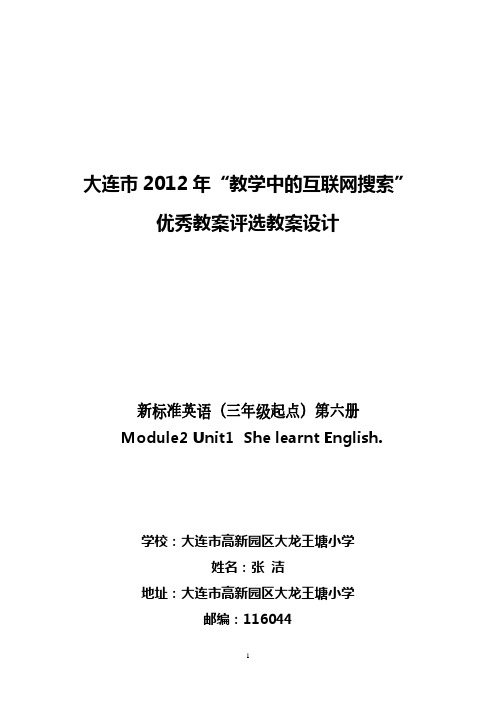
(3)Learn some important sentences:
Did your grandma learn English?Yes, she did./No, she didn’t.
2.Ability aims
(1)Students are able to describe the actions happened with the past tense correctly.
新标准小学英语第六册Module教案
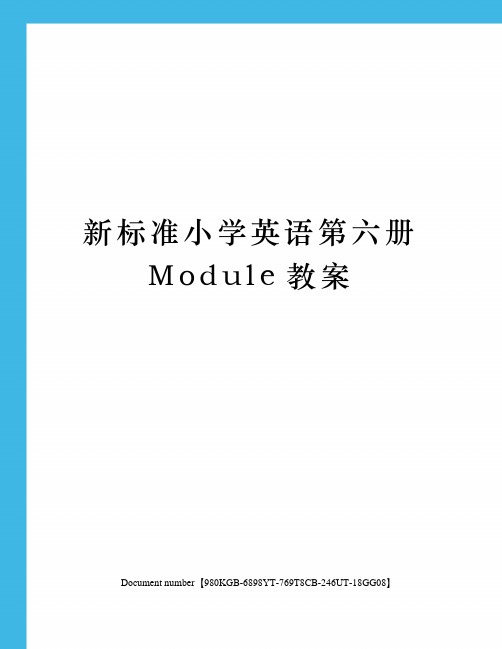
新标准小学英语第六册M o d u l e教案Document number【980KGB-6898YT-769T8CB-246UT-18GG08】Module 8 DiscussionUnit 1 What do you suggest一、教学目标:1.知识目标:能够认读书写单词:suggest, excited, America,Chinese, kind, dragon2.能力目标:能运用句型What do you suggest What about …Why don’t you … How about… 询问以及给别人提出建议。
3.情感目标:引导孩子们做有爱心的好孩子二、课前准备:1、单词卡片: dragon , kite , suggest , America , kind ,Chinese , quickly , excited . 单词卡上有英语和汉语。
2、课件3、课堂练习题一份:两个大题,一、听录音圈出Sam建议大明买的礼物,a dragon kite , a chopsticks , a book , a bag ,a T-shirt , a football.(这道题是图片加单词)二、课堂活动用书第一题,主要考查学生是否理解课文。
三、教学步骤:Step one : 问好和分组1. Teacher : Hi , boys and girls !Pupils : Hi, teacher!Teacher : How are you ,todayPupils : I’m fine , thank you . And youTeacher : I’m fine , too . Thank you .2. 根据班级具体人数,将全班分成三到四个大组,每个大组分成四人一小组。
老师要用自己的激情提起课堂气氛,简单说明比赛得分及最后获胜大组奖励。
先整顿纪律,首先做端正的大组获得两分,其余大组一分。
小学英语外研新标准六年级上册(2022年新编)Module6六上M6U2教案

Module 6第二课时Unit 2 I' ve got some stamps from China.【教学目标】:知识与技能:I' ve got a knife and fork and chopsticks.I' ve got some stamps from China but I haven' t got any stamps from Canada.过程与方法:1.Teach the text with the task based method.2.Do a survey by cooperative learning.3.chant the chant part.情感、态度和价值观:谈论个人所拥有的物品等【重点】:I' V3 gOt句型【难点】:复合句的表述(用and和but)【课时安排】:1课时【教学过程】:(一)导入:1.热身复习2.老师带领学生复习上一模块学习的韵诗。
3.读本模块的单词。
4.导入:Let' s say a chant.Have got ,have got .I/you /we /they.Has got, has got. It /he /she.请一名学生提前做好准备,扮成一位魔术师,从各个地方变出不同的东西。
要求这名学生一边变魔术一边说:“I have got a…?” 然后老师向几位学生提问:“What has he got?”要求学生如实回答。
5.活动一:Use have got/has got to make sentences.课前发给每位学生一张空白表格,但必须限制其中所填内容的种类。
学生可选择画出或写出单词。
如:邮票,餐具,书籍,玩具,宠物,颜色两人一组开展活动。
让生通过提问的方式去猜测别人所拥有的物品有哪些。
并完成下表。
画出或写出你同桌拥有的物品:运用句型:Have you got a knife and fork?Have you got a knife or a fork?(二)探究新知:1.用挂图和录音呈现SB第二单元活动1的内容。
新标准小学英语第六册Moduleunit教学设计教案

Module 10 PreparationsUnit 1 Where are you going to go?教学目标:1、能听、读单词list、airport、shoe、ticket 、toothbrush。
2、能口头运用Where are you going to go ?What are you goingto take?When are you going to go?Who's going to go with you ?谈论旅行前的准备。
3、初步感知本单元对话内容。
教学重点:1、口头运用Where are you going to go ?What are you going to take?When are you going to go?Who's going to go with you ?谈论旅行前的准备。
2、单词的掌握。
教学难点:1、能口头运用Where are you going to go ?What are you going to take?When are you going to go?Who's going to go with you ?谈论旅行前的准备。
2、toothbrush的发音是单词教学中的难点。
教具:100e,IP board, 单词卡片教学步骤:StepI Warming upNod your head!Yes! Yes! Yes!Shake your head !No!No!No!Raise your hand one! two! three!Put down your hand Ok! Ok! Ok!Look at me !Look at him !Look at her!Step II1、Ask :Where did you go on Labour day?What did you take ?I took….(引出本课单词)2、Learn words(电子白板下学习):shoe ticket toothbrush airport list(Fingers game /I think you guess)Step III 1、Review words:where what when who2、Listen look and answerTomorrow ,we are going to go to the Senlin Park to have a picnic,we are going to go there at 7 o'clock ,and we are going to take shoes and food,Miss Wang is going to go with us。
新标准小学英语第六册ModuleUnit教案

You can find out about Chinese words in this dictionary.
You can find out about Chinese food on this CD-ROM.
You can find out about the weather in this newspaper.
Chinese food weather
2.还记得这些词组和句子吗 Where are the books about computers,please They are on Shelf C. in the library at the zoo on TV
听一听、写一写:(预习要求)
1. .认真聆听并跟读本单元的课文 2 遍。 2.在下面的格子里认真抄写 P46 Module4 后 4 个单词 2 遍。
You can find out about…… in/on ……. (重难点)
使用 时间 审核
人
课件 设计
年月 日 陈丽芬 房艳
图片 卡片
请学生说一说平时查找资料和信息时都是通过什么途径找到的。告诉学生今天大家将要学习
如何查询自己需要的相关信息。
理念设计
知识回顾:(相关知识)
1.认读这些单词: find out Chinese words
我收获:
问题留白:
老师提问:
1 说一说平时查找自己需要的资料和信息时,他们都是通过什么途径找到的
can you find out books about animals
我的疑问: x k
巧练Байду номын сангаас练:(基础知识练习)
1.默写这些单词: 信息
字典
外研版三年级英语下册全册教案
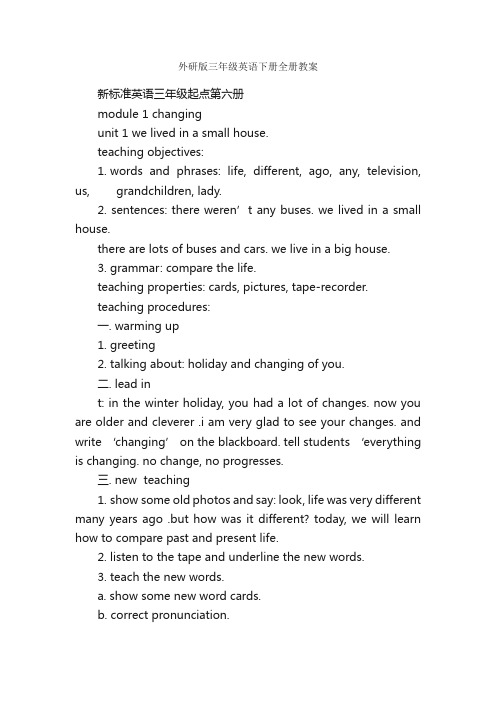
外研版三年级英语下册全册教案新标准英语三年级起点第六册module 1 changingunit 1 we lived in a small house.teaching objectives:1. words and phrases: life, different, ago, any, television, us, grandchildren, lady.2. sentences: there weren’t any buses. we lived in a small house.there are lots of buses and cars. we live in a big house.3. grammar: compare the life.teaching properties: cards, pictures, tape-recorder.teaching procedures:一. warming up1. greeting2. talking about: holiday and changing of you.二. lead int: in the winter holiday, you had a lot of changes. now you are older and cleverer .i am very glad to see your changes. and write ‘changing’ on the blackboard. tell students ‘everything is changing. no change, no progresses.三. new teaching1. show some old photos and say: look, life was very different many years ago .but how was it different? today, we will learn how to compare past and present life.2. listen to the tape and underline the new words.3. teach the new words.a. show some new word cards.b. correct pronunciation.c. practise new words in different kinds of method.d. explain important phrases.4. listen to the tape-recorder and read follow it .5. act out text.四. practise1. pay attention to sb unit1 part2 and copy them to makesentences.2. show some pictures. make some students find differentin them and describe in english.五. summary and homework.1. summaryt: today we have learnt “how to describe past and present life, review simple past tense and present tense.”2. today’s homeworka. listen and read unit1 three times, try to recite and act.b. compare two photos and write differences.designs:module 1 changingunit 1 we lived in a small house.were n’t lived smallare live big新标准英语三年级起点第六册教案module 1 changingunit 2 she didn’t have a television.teaching objectives:1. word and phrases: fire, radio, telephone, field, hope.2. sentences: she worked in the fields. she didn’t have a television.3. grammar: talk about the life of past and now.teaching procedures:一.warming up.1. greetings.2. act out last text.。
外研版新标准英语六年级上册全册教案(小学一年级起点)

(此文档为word格式,下载后您可任意编辑修改!)
课时计划
课时计划年 9 月 6 日
课时计划年 9 月 7 日
课时计划年 9 月 10 日
课时计划年 9 月 9 日
课时计划年 9 月 11 日
课时计划年 9 月 15 日
课时计划年 9 月 16 日
课时计划年 9 月2 1 日
课时计划年 9 月 24 日
课时计划年 9 月 26 日
课时计划年 9 月 27 日
9月28 日做能力培养,以及改错。
10月8日整理一至三模块的知识网络梳理,以及检测重难点知识
课后反思:通过练习,学生们的综合语言运用能力有长进,变换句子结构还有代进行训练。
课时计划年 10 月 11 日
课时计划年 10 月 12 日
课时计划年 10 月 15 日
课时计划年 10 月 18 日
10月19日做课堂练习
10月22日做能力培养
课后反思;通过各种形式练习,教师对本课进行说的能力的培养和训练,达到较好的效果,对划线提问方面的练习还需进一步提高。
课时计划年 10 月19 日
课时计划年 10 月 22 日
课时计划年 10 月 25 日
10、26新课程能力培养
变换词性答得不是很好,需要加强这方面的练习,其他题型学生普遍答得较好。
本模块主要知识点掌握较好。
10、29月考当堂检测
详见卷子。
课时计划年 10 月 29 日
11、1做新课程能力培养
课时计划年 11 月 5 日。
新标准小学三年级英语起点第六册全册教案1-3
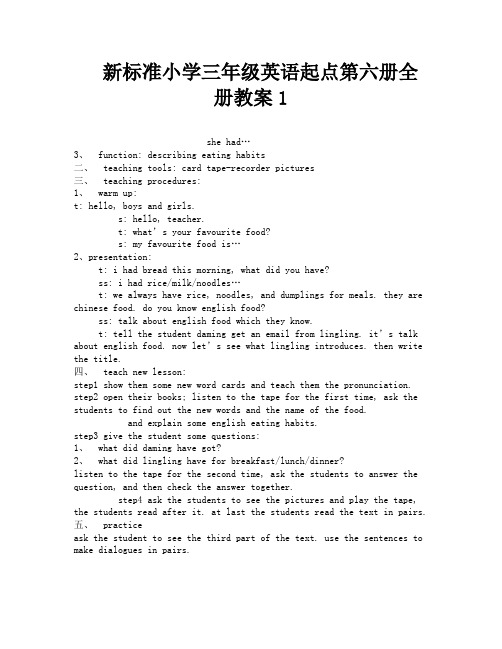
新标准小学三年级英语起点第六册全册教案1she had…3、function: describing eating habits二、teaching tools: card tape-recorder pictures三、teaching procedures:1、warm up:t: hello, boys and girls.s: hello, teacher.t: what’s your favourite foo d?s: my favourite food is…2、presentation:t: i had bread this morning, what did you have?ss: i had rice/milk/noodles…t: we always have rice, noodles, and dumplings for meals. they are chinese food. do you know english food?ss: talk about english food which they know.t: tell the student daming get an email from lingling. it’s talk about english food. now let’s see what lingling introduces. then write the title.四、teach new lesson:step1 show them some new word cards and teach them the pronunciation. step2 open their books; listen to the tape for the first time, ask the students to find out the new words and the name of the food.and explain some english eating habits.step3 give the student some questions:1、what did daming have got?2、what did lingling have for breakfast/lunch/dinner?listen to the tape for the second time, ask the students to answer the question, and then check the answer together.step4 ask the students to see the pictures and play the tape, the students read after it. at last the students read the text in pairs.五、practiceask the student to see the third part of the text. use the sentences to make dialogues in pairs.六、homeworkgo over the text. pay attention to the important sentences and the name of the food.module 3 english foodunit2 sam ate six hamburgers一、teaching objectives:1、words and phrases: ate hamburger gave tonight2、sentences: what did you eat/drink last night?i ate/drank…3、function: talk about eating habits and favourite food二、teaching tools:三、teaching procedures:1、warmer:t: hello.ss: hello teacher.t: what did you have for breakfast this morning?ss: i had…t: what’s your favourite food?ss: my favourite f ood is…3、presentation:take out a picture of hamburger and ask the students “do you like hamburger?” “how many hamburgers can you eat? students answer the questions. t: let’s see how many hamburgers sam can eat. then write the title on the board.。
外研社新标准小学英语第六册各模块教学目标
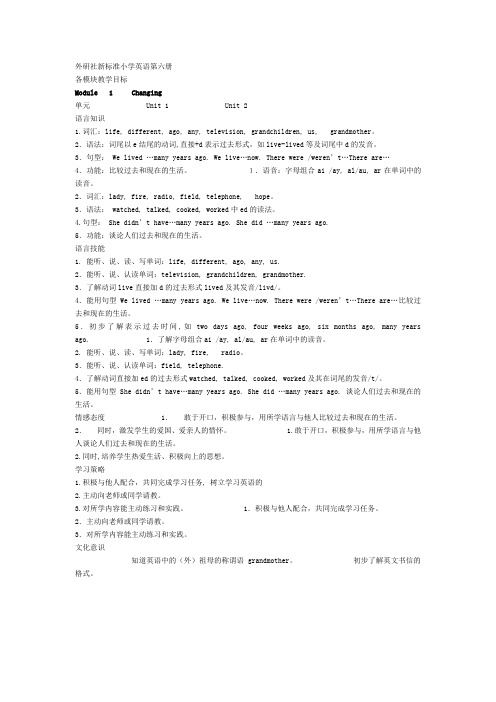
外研社新标准小学英语第六册各模块教学目标Module 1 Changing单元 Unit 1 Unit 2语言知识1.词汇:life, different, ago, any, television, grandchildren, us, grandmother。
2.语法:词尾以e结尾的动词,直接+d表示过去形式,如live-lived等及词尾中d的发音。
3.句型:We lived …many years ago. We live…now.There were /weren’t…There are…4.功能:比较过去和现在的生活。
1.语音:字母组合ai /ay, al/au, ar在单词中的读音。
2.词汇:lady, fire, radio, field, telephone, hope。
3.语法: watched, talked, cooked, worked中ed的读法。
4.句型:She didn’t have…many years ago. She did …many years ago.5.功能:谈论人们过去和现在的生活。
语言技能1. 能听、说、读、写单词:life, different, ago, any, us.2.能听、说、认读单词:television, grandchildren, grandmother.3.了解动词live直接加d的过去形式lived及其发音/livd/。
4.能用句型We lived …many years ago. We live…now. There were /weren’t…There are…比较过去和现在的生活。
5.初步了解表示过去时间,如two days ago, four weeks ago, six months ago, many years ago. 1.了解字母组合ai /ay, al/au, ar在单词中的读音。
2. 能听、说、读、写单词:lady, fire, radio。
新标准小学英语三年级起点第六册教案全册
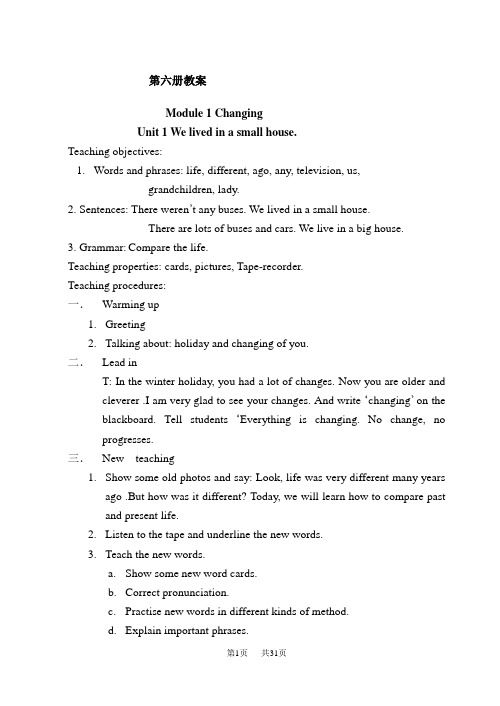
第六册教案Module 1 ChangingUnit 1 We lived in a small house.Teaching objectives:1.Words and phrases: life, different, ago, any, television, us,grandchildren, lady.2. Sentences: There weren’t any buses. We lived in a small house.There are lots of buses and cars. We live in a big house.3. Grammar: Compare the life.Teaching properties: cards, pictures, Tape-recorder.Teaching procedures:一.Warming up1.Greeting2.Talking about: holiday and changing of you.二.Lead inT: In the winter holiday, you had a lot of changes. Now you are older and cleverer .I am very glad to see your changes. And write ‘changing’ on the blackboard. Tell students ‘Everything is changing. No change, no progresses.三.New teaching1.Show some old photos and say: Look, life was very different many yearsago .But how was it different? Today, we will learn how to compare past and present life.2.Listen to the tape and underline the new words.3.Teach the new words.a.Show some new word cards.b.Correct pronunciation.c.Practise new words in different kinds of method.d.Explain important phrases.4.Listen to the tape-recorder and read follow it .5.Act out text.四.Practise1.Pay attention to SB unit1 part2 and copy them to makesentences.2.Show some pictures. Make some students find differentin them and describe in English.五.Summary and homework.1.SummaryT: Today we have learnt “How to describe past and present life, review simple past tense and present tense.”2.Today’s homeworka.Listen and read Unit1 three times, try to recite and act.pare two photos and write differences.Designs:Module 1 ChangingUnit 1 We lived in a small house.weren’t lived smallare live big新标准英语三年级起点第六册教案Module 1 ChangingUnit 2 She didn’t have a television.Teaching objectives:1.Word and phrases: fire, radio, telephone, field, hope.2.Sentences: She worked in the fields. She didn’t have a television.3.Grammar: Talk about the life of past and now.Teaching procedures:一.Warming up.1.Greetings.2.Act out last text.3.Free talk: Compare ‘Old China and New China.’二.Lead inYesterday, Lingling saw the programme about China, she missed her grandmother very much. So she writes a letter forDaming, tells about that programme and her feeling.三.New teaching.1.Show some questions.a.What programme did Lingling watch last night?b.What was the old lady’s life like many years ago?c.Who does Lingling miss?2.Listen to the tape-recorder and find answers.3.Learn new words.a.Show some object and cards.b.Correct pronunciation.c.Practise new words in different kinds of method.4.Listen to the tape-recorder and act out it.四.Practise1.Play a game.Put nine cards on the desk. Two students use cards to make dialogue.For example:A: Where was he/she seven days ago?B: He/She was …A: What did he/she do there?B: He/She …2.Do A B Unit 2 exercise1.a.Listen to the tape.b.Understand generalization.c.Choose right answer.五.HomeworkIntroduce the great changes of our hometown/school/home.新标准英语三年级起点第六册教案Module 2 GrandparentsUnit 1 She learnt English.一、Teaching objectives:1.Words and phrases: learnt these dancer2.Sentences: She learnt English. Did she learn any foreignlanguages. He is learning English now.3.Grammar: Talking about the past and present.4.Teaching properties: word cards photos tape.二、Teaching procedures.一、Warming—upGreeting:T: Hello, Good morning, class. S: Good morning, teacher.T: How are you today? S: We are well.T: What day is today? S: Thursday.T: Are you ready for your English class? S: Yes. We are ready.Game: Review the past tense of some verbs.二、New teachinge some pictures to learn important sentences.Did you/he /she …..? Yes, I/she/he did. No, didn’t.He is doing …….2.Learn new words and phrases.Teacher plays the tape and have Ss underline the new words and phrases. Teacher guides to learn by all kinds of methods.3.Listen and repeat4.Act out the test. (Give Ss some minutes to practise.)三、Practice and consolidate.1.Show two pictures and have Ss describe (use theimportant sentences)2.Do activity3.Have Ss look it , give some minutes to practise in pairs ,then act it out.四、Task—fulfillingGame : teacher have Ss take out their photos and describe it.The others guess it.五、Sum the lesson六、Homework:Try to describe the other persons to your parents.新标准英语三年级起点第六册教案Module 2 GrandparentsUnit 2 Mr Li was a teacher.一.Teaching objectives:1.Words and phrases: study hard retired2.Sentences: Mr Li was a teacher. He taught Chinese.Chen Hai is an English teacher. He’s teaching Mr Li.3. Grammar: Talk about the past and the present.二.Teaching properties: word cards\ Pictures\tape三.Teaching procedures:一、Warming—up1.Greeting : Free talk2.Game: “What did he do?”二、New teaching1.Lead---inTeacher has a student stand in the front of the class.T: Ten years ago ,I was a student .Now, I am a teachet.Ok, let’s come to the text.2.Important words and sentences①Listen and underline the new words. Teacher uses all kinds ofmethods to guide.②Show some pictures and let Ss describe them.③Listen and repeat3.Practice in pairsShow a picture of sports player .Have Ss say out the differences between the pictures.(use the important sentences) Show three pictures and have Ss compare.4. PronunciationHave Ss listen and repeat. Put these words on the Bb. Let them find the similar pronunciation. Follow the tape two times.5.Say a poemLook. Listen and follow the tape. Then say together with actions.三、SummaryHave Ss sum this lesson. Teacher gives complement.四、HomeworkWrite the mutation in your life.新标准英语三年级起点第六册教案Module 3 English FoodUnit 1 She had eggs and sausages一、Teaching objectives1、Words and phrases: email sandwiches traditional delicious2、Sentences: What did she have for breakfast/lunch/dinner?She had…3、Function: Describing eating habits二、Teaching tools: card Tape-recorder pictures三、Teaching procedures:1、Warm up:T: Hello, boys and girls.S: Hello, teacher.T: What’s your favourite food?S: My favourite food is…2、Presentation:T: I had bread this morning, what did you have?Ss: I had rice/milk/noodles…T: We always have rice, noodles, and dumplings for meals. They are Chinese food. Do you know English food?Ss: Talk about English food which they know.T: Tell the student Daming get an email from Lingling. It’s talk about English food. Now let’s see what Lingling introduces. Then write the title.四、Teach new lesson:Step1 Show them some new word cards and teach them the pronunciation.Step2 Open their books; listen to the tape for the first time, ask the students to find out the new words and the name of the food.And explain some English eating habits.Step3 Give the student some questions:1、What did Daming have got?2、What did Lingling have for breakfast/lunch/dinner?Listen to the tape for the second time, ask the students to answer thequestion, and then check the answer together.Step4 Ask the students to see the pictures and play the tape, the students read after it. At last the students read the text in pairs.五、PracticeAsk the student to see the third part of the text. Use the sentences to make dialogues in pairs.六、HomeworkGo over the text. Pay attention to the important sentences and the name of the food.新标准英语三年级起点第六册教案Module 3 English FoodUnit2 Sam ate six hamburgers一、Teaching objectives:1、Words and phrases: ate hamburger gave tonight2、Sentences: What did you eat/drink last night?I ate/drank…3、Function: Talk about eating habits and favourite food二、Teaching tools:三、Teaching procedures:1、Warmer:T: Hello.Ss: Hello teacher.T: What did you have for breakfast this morning?Ss: I had…T: What’s your favourite food?Ss: My favourite food is…3、Presentation:Take out a picture of hamburger and ask the students “Do you likehamburger?” “How many hamburgers can you eat?Studentsanswer the questions. T: Let’s see how many hamburgers Sam caneat. Then write the title on the board.4、Teach new lesson:Step1 T: Take out some new word cards. Ask students to try to read out them, and then teach them these words.Step2 Put on a letter of this unit. Ask students to see the letter and at the same time to listen to the tape. For the first time the students should draw a line under the new words. Then ask them to try to answer these questions:1、Who ate hamburgers?2、Who had a sandwich?3、What is mum going to cook tonight?Step2 Play the tape, the students should read after it. Then check the answers.Step3 Ask the students to see the second part. Use the food to make somedialogues. Students do it in pairs. To see which group is the best.Step4 Game将全班分成几组,教师出示有关食物的卡片,要求学生看到食物后马上造句,哪组有一名学生先站起来,就算哪组先抢达到。
新标准英语三年级起点第六册教案6
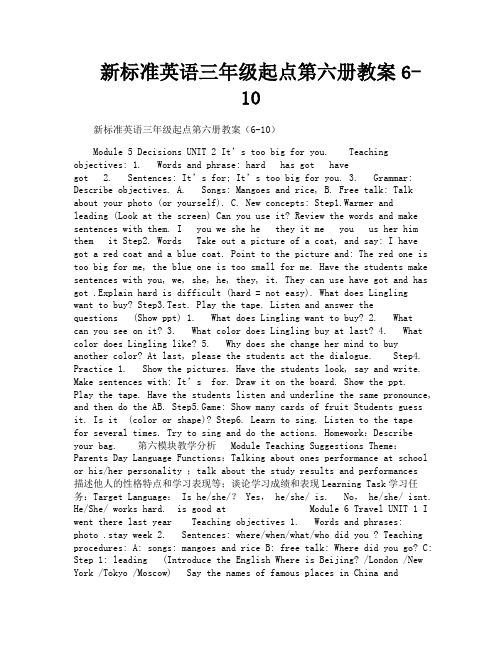
新标准英语三年级起点第六册教案6-10新标准英语三年级起点第六册教案(6-10)Module 5 Decisions UNIT 2 It’s too big for you. Teaching objectives: 1. Words and phrase: hard has got havegot 2. Sentences: It’s for; It’s too big for you. 3. Grammar: Describe objectives. A. Songs: Mangoes and rice, B. Free talk: Talk about your photo (or yourself). C. New concepts: Step1.Warmer andleading (Look at the screen) Can you use it? Review the words and make sentences with them. I you we she he they it me you us her him them it Step2. Words Take out a picture of a coat, and say: I have got a red coat and a blue coat. Point to the picture and: The red one is too big for me, the blue one is too small for me. Have the students make sentences with you, we, she, he, they, it. They can use have got and has got .Explain hard is difficult (hard = not easy). What does Linglingwant to buy? Step3.Test. Play the tape. Listen and answer thequestions (Show ppt) 1. What does Lingling want to buy? 2. Whatcan you see on it? 3. What color does Lingling buy at last? 4. What color does Lingling like? 5. Why does she change her mind to buy another color? At last, please the students act the dialogue. Step4. Practice 1. Show the pictures. Have the students look, say and write. Make sentences with: It’s for. Draw it on the board. Show the pp t.Play the tape. Have the students listen and underline the same pronounce, and then do the AB. Step5.Game: Show many cards of fruit Students guess it. Is it (color or shape)? Step6. Learn to sing. Listen to the tapefor several times. Try to sing and do the actions. Homework:Describe your bag. 第六模块教学分析Module Teaching Suggestions Theme:Parents Day Language Functions:Talking about ones performance at school or his/her personality ;talk about the study results and performances描述他人的性格特点和学习表现等;谈论学习成绩和表现Learning Task学习任务:Target Language: Is he/she/? Yes, he/she/ is. No, he/she/ isnt. He/She/ works hard. is good at Module 6 Travel UNIT 1 I went there last year Teaching objectives 1. Words and phrases:photo .stay week 2. Sentences: where/when/what/who did you ? Teaching procedures: A: songs: mangoes and rice B: free talk: Where did you go? C: Step 1: leading (Introduce the English Where is Beijing? /London /New York /Tokyo /Moscow) Say the names of famous places in China andEngland Step 2: Take out many photos Introduce: This is a photo( 举一张 ). These are photos (举全部,多张照片) Then have the students try to describe the photos. The teacher can say: I stay there for one /two weeks. Explain: ‘stayed’ is the past tense of stay Week: from Sunday and Saturday is one week. Step 3: Playing the tape So that the students can listen to the conversations and follow in the books Tell each pupil to get a piece of paper and draw a question on it. Ask the studentsto close their books Play the dialogue part by part and have to listen. If they have a question, they have to hold up their pieces of paper and say questions . Now tell the students to open their books and underline all the questions in the dialogue Have the students answer the questions Do Activity book Exercise 1 Step 4: Show the pictures and have the student try to say and write. Use the drills. At last give them answers Who has got some photos? Where isLingling? When did Lingling go there? Who did she gowith? Where does her uncle live? Steps 5: Activity book Exercise 3 Homework: Talking about where you went? And write down Module 6 Travel Unit 2 It is in the north of China Teaching objectives 1. Words and phrases: parent rode horse climb 2. Sentences: It is in the north of China Where is ? It is in Teaching procedures: A: Songs: mangoes and rice B: Free talk: Where did you go? C: New concepts Step1. New words Show the cards of the new word. Have the student read and remember them Then explain the word: parent means mother or father; Holiday means the day that you do not work or study, you are free. Step 2. Test Play the tape, have the students open their books listen and read then answer the questions 1. Where did Lingling go?2. When did she go?3. Who did she go with?4. Where is Xinjiang?5. What did she ride?6. What mountain did she climb?7. What lake did she visit?8. Did she have a good time? At last give answer to the students Step3. On the blackboard, mark north at the top, south at the bottom, west on the left, east on the right. Read and point Show a mapof China on the blackboard and ask: Where is Haikou?/Yinchuan/Shanghai/Hetian /Hong Kong Practice: Have the students talk about their holiday. If they did not go anywhere, imagine. Step4. Listen and repeat again, then do Activity book Exercise 4 Step5. Sing a song Play the tape and the student learn to sing Game: Draw a picture (in the south draw some mountains, in the north draw a river, in theeast draw a road, in the west draw a kite ) Homework: Write and draw 1. Where is your favourite place? 2. When did you go there? 3. What did you do there? 4. Who did you go with? 第七模块单元分析 Module Teaching Suggestions Theme: Changes LanguageFuntions:Describing changes;Describing the features and the state of the past things,Comparing the present with the past说明过去的特征与状态,比较现在和过去;Learning Task学习任务:Target Language: was/were then. Now is/are Module 7 Communications Unit 1 Let’s send an email. 教学目标:1、单词及短语:message,another,idea,office,busy 2、重点句子:Let’s send an email to dad. Click on‘email’. Write your message. 3、情景运用:学习如何发送电子邮件。
- 1、下载文档前请自行甄别文档内容的完整性,平台不提供额外的编辑、内容补充、找答案等附加服务。
- 2、"仅部分预览"的文档,不可在线预览部分如存在完整性等问题,可反馈申请退款(可完整预览的文档不适用该条件!)。
- 3、如文档侵犯您的权益,请联系客服反馈,我们会尽快为您处理(人工客服工作时间:9:00-18:30)。
新标准五年级英语第六册公开课教案
Module 1
Unit 2------She didn’t have a television
市一小英语组刘红兰
2012.3.1
新标准五年级英语第六册
Teaching Plan
Module 1
Unit 2------She didn’t have a television
英语组刘红兰
Teaching aims
1.Can skill new words and phrases: television programme fire telephone field
radio on a fire in the fields last night
2.Get students to describing sth in the past. and now.
Teaching Focus
1、Encourage students to cooperate with each other, then describing sth in
the past. and now.
2、Grammar: or but and
Teaching aids
Tape recorder some cards and pictures
Teaching process
Step 1、Warm-up
1 . Show some star s′photos (蒋雯丽李玉刚)to students and ask:
Who is he / she?
Where did he / she work?
What was he /she?
2. T: Let’s have a look at an old lady’s old memory.
Step 2 Listening and reading
1.Draw five pictures on the blackboard
cooked on a fire.
didn’t have a television or a radio
didn’t have a tevephone
worked in the fields
cou ldn’t read or write
2.Ask students to look and guess their meanings
3.Read them one by one: words phrases sentences Eg: fire on a fire cooked on a fire
She cooked on a fire.
4 Let the students to read them.
5 Explain the difficult points:
Y es and Y es eg: 1 I have a apple_and_ pear.
Y es/ No but Y es/ No 2 I have a apple but I don’t
have a pear.
No or No 3 I don’t have a apple or I don’t
have a pear.
6 Show parts of the sentences to students and ask them to describe the sentence together.
7 Let students practice the key sentences and remember quickly.
Step 3 listening and activities
1 Books open, play the tape first, ask students to answer
2 questions:
Q 1: What programme did Lingling watch last night?
Q2: Who does Lingling miss?
2 Play it again, Let the students to read the text.
3 Show parts of text and ask students to describe it.
Step 4 Further Development
1 Learn to read some information about our life in the past and now
Eg: cars tall building use natural gas cooking (用天然气做饭) Korla our school
2 Ask students to describe phrases.
3 Try to make sentences
4 Describe the dialogue.
Step 5 What should we do
Eg: respect old and love young(尊老爱幼)
Don’t waste food (不浪费粮食)…
Step6 Homework
1 Recite and read the text.
2 Remember the new words.
(The end)。
